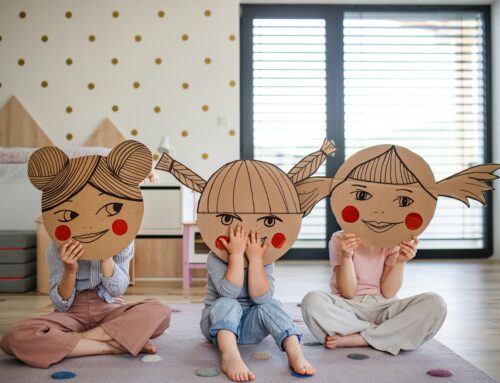The family entering the office was visibly uncomfortable. This was the first time they’d been in for family counseling. Mom and Dad put on brave smiles, the younger children were excited to find toys, and the teen seemed like the parents had dragged them in. As they got settled in and started sharing some of their struggles as a family, one thing became clear: this family needed tools for managing stress and emotions.
“I don’t want to be at the mercy of my emotions. I want to use them, to enjoy them, and to dominate them.” – Oscar Wilde
 Families with this struggle come into the office all the time. Managing stress and emotions is something almost everyone needs help with at one point or another. When the parents heard this, they relaxed. They felt like they’d failed their children and were bad parents. In reality, most Americans are ill-equipped to handle emotions and stress. Carlsbad Christian Counseling is here to help families navigate these challenges. Through expert guidance and support, we can assist you in managing stress, improving emotional resilience, and fostering healthier family dynamics.
Families with this struggle come into the office all the time. Managing stress and emotions is something almost everyone needs help with at one point or another. When the parents heard this, they relaxed. They felt like they’d failed their children and were bad parents. In reality, most Americans are ill-equipped to handle emotions and stress. Carlsbad Christian Counseling is here to help families navigate these challenges. Through expert guidance and support, we can assist you in managing stress, improving emotional resilience, and fostering healthier family dynamics.
When children are younger it feels a lot easier to help in this area. As kids grow, their emotions become deeper and stress levels grow. This is when parents often start to struggle. Once confident parents may find they get in over their heads following a stressful or traumatic situation or event. This is normal, most people are not taught many coping skills for these types of things.
Fortunately, these are tools that schools, churches, and even doctors are starting to teach. Families and individuals can all benefit from additional support from a counselor too. Managing stress and regulating emotions will be a lifelong journey for us. There will always be something new to learn and personal development in this area.
Today let’s take a look at some tips for healthy emotional expression and stress management tools for all ages. Choose a couple of these to start trying for a few weeks. Not every tip will work for everyone, find what works for you, and leave the rest!
Tips for Managing Stress, Emotion Expression & Regulation
 An emotions chart. This works especially well with young children. Teens and adults can benefit from these too. All kinds of charts from cartoon characters to photos and even emoji-based charts show pictorial representations of different emotions. Most have a couple of dozen. They can be used to teach new emotion-words and discuss emotions outside of the “heat of the moment.”
An emotions chart. This works especially well with young children. Teens and adults can benefit from these too. All kinds of charts from cartoon characters to photos and even emoji-based charts show pictorial representations of different emotions. Most have a couple of dozen. They can be used to teach new emotion-words and discuss emotions outside of the “heat of the moment.”
They’re also helpful tools for times of high emotion or moments when perhaps we’re not quite sure what we feel. The picture best representing the emotion can be pointed to, or circled, to communicate to others what the feeling is. Kids and teens who feel reluctant to share emotions out loud, or who have verbal delays, may especially benefit from these.
Those who are more visual learners and processors also benefit as do those with Autism and Asperger Syndrome. Some folks even use them at the end of the day as a way to recap how the day went. There are lots of ways to use this tool!
Deep breathing. Kids can begin working on this when they are very young. Adults can model this with children from infancy. There are dozens of suggested breathing patterns and systems out there. Alternate nostril breathing and box breathing are two of the most common. They all share the same premise; deep breathing helps us calm down and process our feelings.
Deep breathing is most often used during feelings of anger, anxiety, worry, frustration, fear, panic, and other similar emotions. However, there’s never a bad time to breathe deeply! Deep breathing has also been shown to be helpful for stress management- even just a minute or two a day can help.
 Journaling. It seems almost everyone knows they should journal, but most people don’t. The benefits of journaling are numerous. Next to deep breathing, it is the most accessible and inexpensive option for stress management, emotion expression, and emotion regulation. Our journal can be there for our biggest, strongest, most intense emotions and our journal can be there on a ho-hum normal day when we don’t feel a lot.
Journaling. It seems almost everyone knows they should journal, but most people don’t. The benefits of journaling are numerous. Next to deep breathing, it is the most accessible and inexpensive option for stress management, emotion expression, and emotion regulation. Our journal can be there for our biggest, strongest, most intense emotions and our journal can be there on a ho-hum normal day when we don’t feel a lot.
The journal can be a place to work out ideas, schedule, vent, and process the world. Folks also find journaling helpful during periods of high stress. Many report that they figured out some way to help ease their stress during journaling. Kids and adults can journal. Children may choose to draw or write something silly too. These are ok. They’ll learn in time how to express their feelings more fully but sometimes being silly or artistic is the best way for a kid to process their emotions and unwind.
Movement: Yoga, walking, running, lifting weights, and so many other options exist here. Studies and first-hand experience show that those who get plenty of movement handle stress better and naturally regulate emotions better in addition to the obvious physical health benefits.
Aim for at least an hour a day of movement, even if that means starting with a gentle walk. Trying movement in the middle of intense emotion can also be helpful. Children often calm down when they jump on a trampoline, do gymnastics, swing, hit a baseball or softball, do yoga, or run.
The Arts. Creating something and enjoying the creations of others has incredible healing and calming power. Try drawing, coloring, painting, sculpting, or another type of craft during a time of high-emotion or stress. This can be a good way to reset a family and help calm everyone down too. Many parents have pulled out the craft supplies when kids were stressed out or in a high-emotion setting.
Playing and listening to music, dancing, and engaging in theater can also be healing and calming. Give something new a try in the arts next time you’re stressed or upset. Turn off the smartphone and get a bit of time alone to see what comes from it. Art therapy and music therapy are also an option for those who would like to delve in a bit deeper.
Time Alone. Let’s face it, it’s much more difficult to figure out what we’re feeling when others are around. We sometimes need time alone. Some families and schools, churches, etc. have a specific space set aside for when someone needs time alone. Adults may suggest a child go to that spot if it seems they need a break to process their feelings.
 Even if there’s not a designated space, everyone should be taught that it is ok to ask for time alone and to be respected when that request is made. Some kids do not want to be alone when they’re stressed or feeling a strong emotion, so never force them to be alone.
Even if there’s not a designated space, everyone should be taught that it is ok to ask for time alone and to be respected when that request is made. Some kids do not want to be alone when they’re stressed or feeling a strong emotion, so never force them to be alone.
Water. We often forget to get a drink of water when we’re emotional or stressed. Yet this can be one of the best ways to reset ourselves a bit and get a clearer head, especially if we’re dehydrated. We can also take a bath or a shower.
You’ve likely experienced how much something so simple as a shower or bath can turn around your mood or lower your stress. Sitting by a body of water or a river is also calming and relaxing. Water is a gift God gave us and there are many ways it can help us with managing stress and emotions. If you’re finding it difficult to manage stress or emotions, contact counselors at Carlsbad Christian Counseling for guidance and support.
Modeling. When adults model emotional expression and regulation, kids pay attention. It may feel silly at first, but adults can practice saying “I feel ____. I’m going to ______ to help me with this feeling.” For example, “I feel frustrated that traffic is so bad. I’m going to take some deep breaths to calm myself down.” or “I feel sad about our trip being canceled. I’m going to journal for a while to write about my sadness.”
Adults can also be vocal about the things they do to manage stress. Modeling these activities and choices also helps kids to know you’re not asking them to do anything you don’t do yourself.
“Line Chart”, Courtesy of Isaac Smith, Unsplash.com, CC0 License; “Standing by the Pier”, Courtesy of Joshua Yu, Unsplash.com, CC0 License; “Bible and Journal”, Courtesy of Carolyn V, Unsplash.com, CC0 License; “Painting”, Courtesy of Sincerely Media, Unsplash.com, CC0 License
-
Kate Motaung: Curator
Kate Motaung is the Senior Writer, Editor, and Content Manager for a multi-state company. She is the author of several books including Letters to Grief, 101 Prayers for Comfort in Difficult Times, and A Place to Land: A Story of Longing and Belonging...
DISCLAIMER: THIS ARTICLE DOES NOT PROVIDE MEDICAL ADVICE
Articles are intended for informational purposes only and do not constitute medical advice; the content is not intended to be a substitute for professional medical advice, diagnosis, or treatment. All opinions expressed by authors and quoted sources are their own and do not necessarily reflect the opinions of the editors, publishers or editorial boards of Stone Oak Christian Counseling. This website does not recommend or endorse any specific tests, physicians, products, procedures, opinions, or other information that may be mentioned on the Site. Reliance on any information provided by this website is solely at your own risk.








